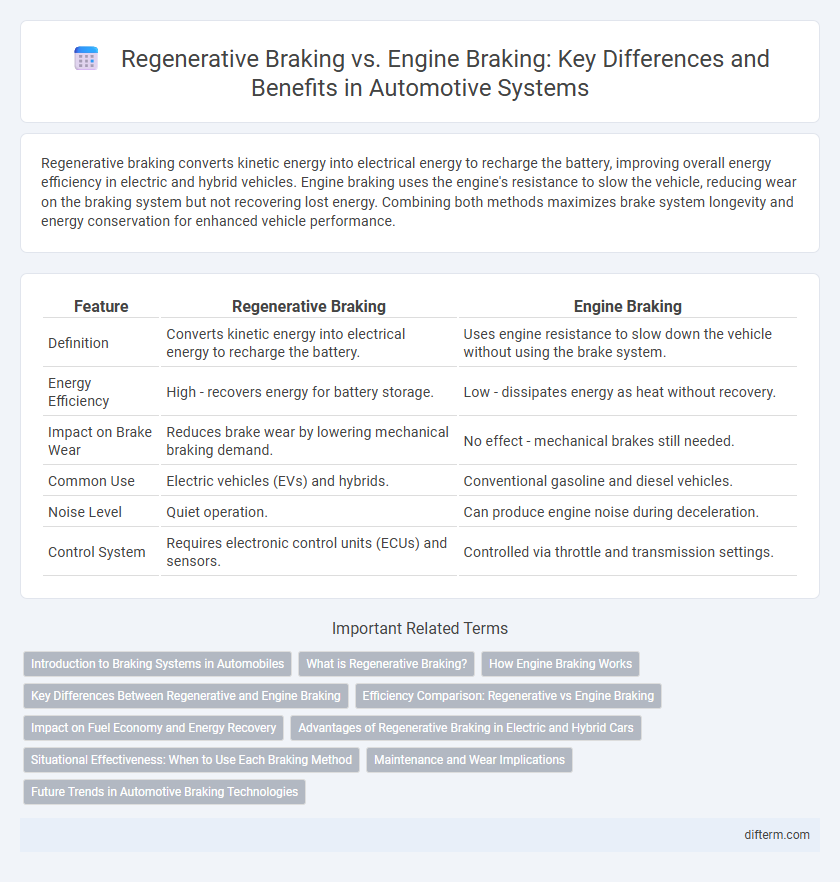Regenerative braking converts kinetic energy into electrical energy to recharge the battery, improving overall energy efficiency in electric and hybrid vehicles. Engine braking uses the engine's resistance to slow the vehicle, reducing wear on the braking system but not recovering lost energy. Combining both methods maximizes brake system longevity and energy conservation for enhanced vehicle performance.
Table of Comparison
| Feature | Regenerative Braking | Engine Braking |
|---|---|---|
| Definition | Converts kinetic energy into electrical energy to recharge the battery. | Uses engine resistance to slow down the vehicle without using the brake system. |
| Energy Efficiency | High - recovers energy for battery storage. | Low - dissipates energy as heat without recovery. |
| Impact on Brake Wear | Reduces brake wear by lowering mechanical braking demand. | No effect - mechanical brakes still needed. |
| Common Use | Electric vehicles (EVs) and hybrids. | Conventional gasoline and diesel vehicles. |
| Noise Level | Quiet operation. | Can produce engine noise during deceleration. |
| Control System | Requires electronic control units (ECUs) and sensors. | Controlled via throttle and transmission settings. |
Introduction to Braking Systems in Automobiles
Regenerative braking captures kinetic energy during deceleration, converting it into electrical energy to recharge the vehicle's battery, primarily used in hybrid and electric vehicles. Engine braking reduces speed by downshifting and using engine resistance to slow the car without applying the brake pads, commonly found in conventional internal combustion engine vehicles. Both systems enhance energy efficiency and control but operate on fundamentally different mechanical and electrical principles.
What is Regenerative Braking?
Regenerative braking recovers kinetic energy during deceleration by converting it into electrical energy stored in the vehicle's battery, enhancing overall efficiency and extending driving range. This system uses electric motors as generators, reducing wear on traditional brake components and contributing to lower maintenance costs. Predominantly found in hybrid and electric vehicles, regenerative braking supports energy conservation and improves fuel economy.
How Engine Braking Works
Engine braking works by using the engine's resistance to slow down the vehicle, achieved when the throttle valve closes and the engine restricts airflow, creating a vacuum that reduces speed. This process converts the vehicle's kinetic energy into heat within the engine cylinders, avoiding wear on the brake pads. Unlike regenerative braking, engine braking does not recover energy but provides effective speed control, especially on steep declines.
Key Differences Between Regenerative and Engine Braking
Regenerative braking recovers kinetic energy during deceleration by converting it into electrical energy stored in the battery, improving fuel efficiency in electric and hybrid vehicles. Engine braking relies on the engine's resistance to slow down the vehicle, reducing brake wear but not recovering energy. Regenerative systems are more effective at energy conservation, whereas engine braking is simpler and commonly found in conventional internal combustion engine vehicles.
Efficiency Comparison: Regenerative vs Engine Braking
Regenerative braking converts kinetic energy into electrical energy, improving overall vehicle efficiency by recharging the battery and reducing energy waste, especially in electric and hybrid vehicles. Engine braking dissipates energy as heat through engine resistance, resulting in lower energy recovery and increased fuel consumption compared to regenerative systems. Studies show regenerative braking can recover up to 70% of kinetic energy, significantly outperforming traditional engine braking in energy efficiency.
Impact on Fuel Economy and Energy Recovery
Regenerative braking significantly enhances fuel economy by converting kinetic energy into electrical energy, which is stored in the battery for later use, reducing overall fuel consumption. Engine braking, while helping control vehicle speed without using the brake system, provides minimal impact on fuel savings since it primarily relies on engine resistance rather than energy recovery. Vehicles equipped with regenerative braking systems, particularly hybrids and electric cars, demonstrate superior energy efficiency compared to those relying solely on engine braking.
Advantages of Regenerative Braking in Electric and Hybrid Cars
Regenerative braking in electric and hybrid cars enhances energy efficiency by converting kinetic energy into electrical energy, which recharges the battery and extends driving range. This system reduces wear on traditional brake components, lowering maintenance costs and improving overall vehicle durability. Furthermore, regenerative braking contributes to environmental sustainability by decreasing energy consumption and carbon emissions compared to conventional engine braking methods.
Situational Effectiveness: When to Use Each Braking Method
Regenerative braking is most effective in urban driving with frequent stop-and-go conditions, as it captures kinetic energy to recharge the battery and improve overall efficiency. Engine braking proves advantageous on long downhill gradients, helping to maintain controlled speed without overheating the braking system while reducing wear on brake pads. Selecting the appropriate braking method depends on driving scenarios, optimizing fuel economy, safety, and vehicle longevity.
Maintenance and Wear Implications
Regenerative braking significantly reduces wear on traditional brake components like pads and rotors by converting kinetic energy into electrical energy, thereby extending maintenance intervals. Engine braking, while effective for speed control, places mechanical stress on the engine and transmission, potentially increasing the frequency of inspections and component replacements. Prioritizing regenerative braking can lower maintenance costs and enhance overall vehicle longevity by minimizing reliance on friction-based braking systems.
Future Trends in Automotive Braking Technologies
Regenerative braking systems are increasingly integrated with electric and hybrid vehicles, capturing kinetic energy to improve energy efficiency and reduce emissions. Engine braking remains relevant in heavy-duty and conventional vehicles, offering enhanced control and safety without additional energy use. Future trends emphasize advanced braking algorithms and seamless integration of regenerative and engine braking to optimize performance and sustainability in automotive applications.
Regenerative braking vs Engine braking Infographic

 difterm.com
difterm.com